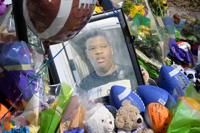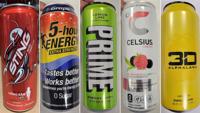A month after a to his ride, his family is suing a bevy of defendants, saying a series of mistakes put visitors in danger and led to their child's fatal fall.
Tyre Sampson was visiting ICON Park on March 24 when , described by its operators as the world's tallest freestanding drop tower. It sends passengers up and then drops them nearly 400 feet at speeds reaching more than 75 mph, according to the park.
Horrific bystander video shows Tyre -- who weighed about 380 pounds, the suit states, and was known to loved ones as a -- slipping out of the ride and falling to his death. A harness sensor in Tyre's seat had been allowing for a greater gap than normal between his harness and his seat, an investigation by a forensic engineering firm commissioned by Florida officials found.
Defendants in the lawsuit, filed Monday in state court, include ICON Park; SlingShot, which owns and operates the Orlando FreeFall; the ride's manufacturer, Austria-based Funtime Handels; and the manufacturer of the seats and harnesses, Germany-based Gerstlauer Amusement Rides.
Last week, ICON Park said it is "deeply troubled that the preliminary findings of the state's investigation indicate a sensor on the Orlando FreeFall attraction, which is owned and operated by the SlingShot Group, had been mis-adjusted after the sensor was originally secured in place."
"ICON Park is committed to providing a safe, fun experience for families. We will continue to support the Florida Department of Agriculture and Consumer Services with their ongoing investigation," the statement read.
Orlando SlingShot attorney Trevor Arnold last week said, "all protocols, procedures and safety measures provided to us by the manufacturer of the ride were followed."
Funtime Handels and Gerstlauer Amusement Rides did not immediately respond to CNN's requests for comment.
A seat belt and posted weight limit would have helped, lawsuit says
"While most free fall rides of this type have both a shoulder harness and a seatbelt, this subject Free Fall ride only had an over-the-shoulder harness to 'secure' riders," the lawsuit states.
To outfit the ride with the seat belt combination, "All of the seats combined would cost approximately $660," according to the lawsuit. And that could have saved Tyre's life, said Michael Haggard, the attorney representing Tyre's mother, Nekia Dodd.
"What's really sad about this is that had they put the seat belt in, it would have cost $22 (per seat). You would have paid for that in two to three rides," Haggard told CNN on Monday. "In one night, this would have been paid for and this would have never happened."
There were no clear weight limits nor scales at the ride site -- even though the ride tilted about 30 degrees forward -- the suit states. Haggard said he was appalled by that omission.
The lawsuit also states "a reasonable manufacturer, constructor, operator, distributor, designer, and supplier" would have installed a mechanism to stop operation of the ride if a rider's restraint was not properly secured and also not allow the sensors to be manipulated or adjusted.
What the family wants
Tyre's parents, Dodd and Yarnell Sampson, are seeking damages including the costs of medical care and funeral arrangements and compensation for the mental pain and suffering from the death of their son, the suit states.
The family has asked for a jury trial.
Ultimately, Tyre's mother wants to make sure "this never happens again -- not only at this facility, but that this never happens anywhere again in the United States," Haggard said.
The-CNN-Wire
� & © 2022 Cable News Network, Inc., a WarnerMedia Company. All rights reserved.














